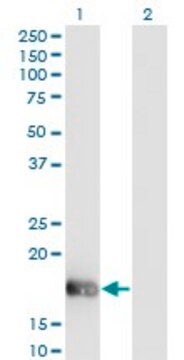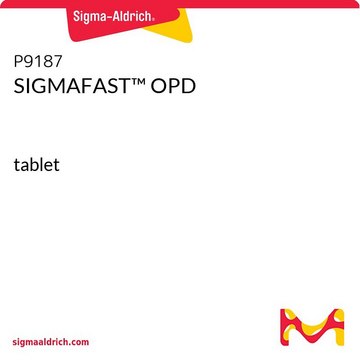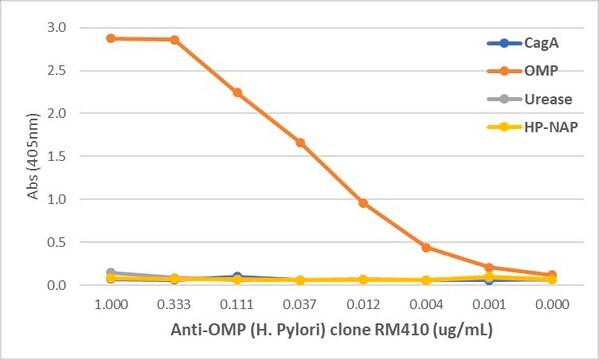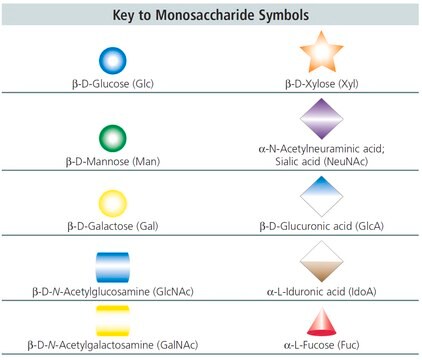推荐产品
生物源
rabbit
共軛
unconjugated
抗體表格
affinity isolated antibody
抗體產品種類
primary antibodies
無性繁殖
polyclonal
形狀
buffered aqueous solution
分子量
antigen ~19 kDa
物種活性
rat, mouse
濃度
~2 mg/mL
技術
western blot: 0.5-1.0 μg/mL using rat brain (olfactory bulb) extract (S1 fraction).
UniProt登錄號
運輸包裝
dry ice
儲存溫度
−20°C
目標翻譯後修改
unmodified
基因資訊
rat ... Omp(24612)
一般說明
Olfactory marker protein (OMP) is a phylogenetically conserved cytoplasmic protein of unknown function expressed almost exclusively in mature olfactory sensory neurons, in essentially all vertebrate species. OMP is expressed in both the olfactory neuroepithelium and the olfactory nerve projection to the olfactory bulb. In perikaryon, OMP is produced and are transported to the dendrite and axon in the glomerular layer of the olfactory bulb.
Olfactory marker protein (OMP) is a phylogenetically conserved, 19kDa, cytoplasmic protein of unknown function expressed almost exclusively in mature olfactory sensory neurons, in essentially all vertebrate species. The gene encoding OMP is localized on rat chromosome 1. OMP expression is initially detected in rat and mouse embryo during the last trimester of gestation and reaches adult levels at 2-4 weeks postnatally. It has been suggested that OMP is a novel modulatory component of the odor detection signal transduction cascade that is developmentally and physiologically regulated.
免疫原
synthetic peptide corresponding to amino acids 119-137 located near the C-terminus of rat OMP conjugated to KLH.
應用
Anti-OMP antibody produced in rabbit has been used in immunohistochemistry.
Anti-OMP antibody produced in rabbit has been used in:
- immunoblotting
- double immunofluorescence
- staining
生化/生理作用
Olfactory marker protein (OMP) helps to modulate the formation and refinement of the olfactory glomerular map. OMP-deficient mice generated by gene targeting in embryonic stem (ES) cells are compromised in their ability to respond to odor stimuli. In the OMP-null mouse, in addition to reduced odorant response, the levels of neural tyrosine hydroxylase (TH) and neuropeptide cholecystokinin (CCK) are severely reduced. It has been suggested that OMP is a novel modulatory component of the odor detection signal transduction cascade that is developmentally and physiologically regulated.
外觀
0.01M 磷酸缓冲盐溶液,pH 7.4,含 15mM 叠氮化钠。
免責聲明
Unless otherwise stated in our catalog or other company documentation accompanying the product(s), our products are intended for research use only and are not to be used for any other purpose, which includes but is not limited to, unauthorized commercial uses, in vitro diagnostic uses, ex vivo or in vivo therapeutic uses or any type of consumption or application to humans or animals.
未找到合适的产品?
试试我们的产品选型工具.
儲存類別代碼
10 - Combustible liquids
水污染物質分類(WGK)
WGK 3
閃點(°F)
Not applicable
閃點(°C)
Not applicable
個人防護裝備
Eyeshields, Gloves, multi-purpose combination respirator cartridge (US)
Expression of CD36 by olfactory receptor cells and its abundance on the epithelial surface in mice
Lee S, et al.
PLoS ONE, 10(7), e0133412-e0133412 (2015)
Diverse populations of intrinsic cholinergic interneurons in the mouse olfactory bulb
Kurt K
Neuroscience, 161-178 (2012)
Olfactory marker protein (OMP) gene deletion causes altered physiological activity of olfactory sensory neurons
Buiakova OI, et al.
Proceedings of the National Academy of Sciences of the USA, 93(18), 9858-9863 (1996)
Backbone dynamics of the olfactory marker protein as studied by 15N NMR relaxation measurements.
Biochemistry, 44(28), 9673-9679 (2005)
Olfactory marker protein (OMP) gene deletion causes altered physiological activity of olfactory sensory neurons.
Proceedings of the National Academy of Sciences of the USA, 93(18), 9858-9863 (1996)
我们的科学家团队拥有各种研究领域经验,包括生命科学、材料科学、化学合成、色谱、分析及许多其他领域.
联系技术服务部门








